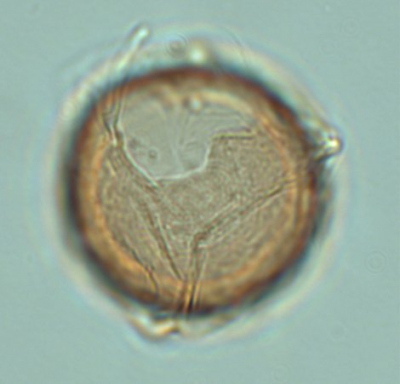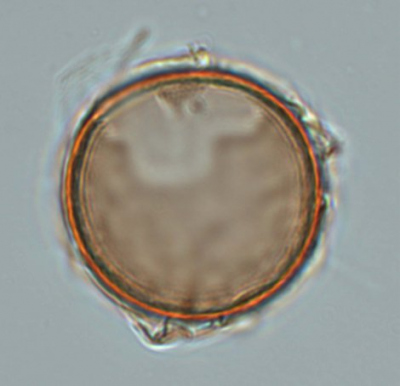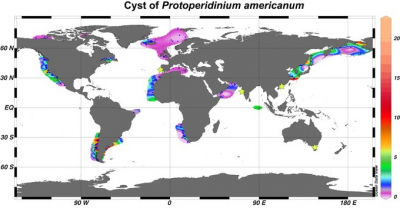Page path:
- Modern Dinocyst Key
- brown cysts
- round brown with septa, reticulation, double wall
- round brown cysts with double wall
- Cyst of Protoperidinium americanum
Cyst of Protoperidinium americanum
Zonneveld, K.A.F. and Pospelova V. (2015). A determination key for modern dinoflagellate cysts. Palynology 39 (3), 387- 409.

dorsal view
photo by Karin Zonneveld

cross section
photo by Karin Zonneveld
photo by Karin Zonneveld
field characteristics
Cyst of Protoperidinium americanum (Gran and Braarud) Balech
Field characteristics:
Spherical brown cyst without processes or spines. The cyst-wall is composed of two layers. The inner layer is mooth and overlain by a granular outher layer. The other layer can be compressed to the inner layer on several places but at other parts is loosely formed around the inner layer. No tabulation is reflected other than the archeopyle which is formed by the loss of the 2th, 3th and 4th apical plates.
Dimensions: Cyst diameter: 35 - 52 µm.
Motile affinity: Protoperidinium americanum
Cyst theca relationship: Lewis and Dodge, 1987
Stratigraphic range: Holocene
Comparison with other species:
This species is easily to distinguish as it is the only brown coloured cyst species with a double cyst wall and an apical archeopyle that is formed by the loss of three apical plates. This species can be confused with cysts of cyst of Protoperidinium parthenopes (Kawami and Matsuoka 2009). Cysts of Protoperidinium parthenopes are slightly smaller (24-34 mm), pale brown in coulor, differ in the shape of the periphragm and the archeopyle. According to Kawami and Matsuoka, 2009 the periphragm of P. amiricanum is connected more often to the endophragm and remains the operculum of the archeopyle seldom attached.
Field characteristics:
Spherical brown cyst without processes or spines. The cyst-wall is composed of two layers. The inner layer is mooth and overlain by a granular outher layer. The other layer can be compressed to the inner layer on several places but at other parts is loosely formed around the inner layer. No tabulation is reflected other than the archeopyle which is formed by the loss of the 2th, 3th and 4th apical plates.
Dimensions: Cyst diameter: 35 - 52 µm.
Motile affinity: Protoperidinium americanum
Cyst theca relationship: Lewis and Dodge, 1987
Stratigraphic range: Holocene
Comparison with other species:
This species is easily to distinguish as it is the only brown coloured cyst species with a double cyst wall and an apical archeopyle that is formed by the loss of three apical plates. This species can be confused with cysts of cyst of Protoperidinium parthenopes (Kawami and Matsuoka 2009). Cysts of Protoperidinium parthenopes are slightly smaller (24-34 mm), pale brown in coulor, differ in the shape of the periphragm and the archeopyle. According to Kawami and Matsuoka, 2009 the periphragm of P. amiricanum is connected more often to the endophragm and remains the operculum of the archeopyle seldom attached.
Geographic distribution
Geographic distribution based on :
Zonneveld et al., 2013. Atlas of modern dinoflagellate cyst distribution based on 2405 datapoints. Review of Palaeobotany and Palynology, v. 191, 1-197
The distribution of cysts of Protoperidinium americanum is coastal sub-polar to tropical in regions where eutrophic conditions can prevail during parts of the year, for instance as the result of upwelling. So far it is not observed in regions that are influenced by river discharge. In the upwelling regions of NW Africa and the Arabian Sea highest cyst production occurs during upwelling.
Zonneveld et al., 2013. Atlas of modern dinoflagellate cyst distribution based on 2405 datapoints. Review of Palaeobotany and Palynology, v. 191, 1-197
The distribution of cysts of Protoperidinium americanum is coastal sub-polar to tropical in regions where eutrophic conditions can prevail during parts of the year, for instance as the result of upwelling. So far it is not observed in regions that are influenced by river discharge. In the upwelling regions of NW Africa and the Arabian Sea highest cyst production occurs during upwelling.

Distribution:
Cysts of Protoperidinium americanum have only been reported from coastal sub-polar to tropical regions except for a few sites in the open North Atlantic Ocean and equatorial Indian Ocean. The cysts of this species are recorded only twice in equatorial sites. Abundances >5% and up to 18% occur in the vicinity of upwelling cells off western North America (Eastern Pacific), on the margins of the NW Pacific, off Chilli (southeastern Pacific), off NW Africa and off SW Africa. It is not observed where surface waters are influenced by river discharge.
Environmental parameter range:
SST: -2.9 - 29.4°C (winter - spring) with summer SST: > 2.6°C except for one site where summer SST: 0.9°C. SSS: 25 - 38.2 (summer - autumn) except for two sites where SSS drops in summer to 18.3 and 20.9. [P]: 0.08 - 1.7 μmol/l, [N]: 0.09 - 18.6 μmol/l, chlorophyll-a: 0.08 - 20.0 ml/l, bottom water [O2]: 0 - 7.9 ml/l.
Although cysts of Protoperidinium americanum have their highest relative abundance in eutrophic environments, they are observed in oligotrophic environments as well. The species is abundant in upwelling areas where large inter-annual variability in the trophic state of the upper waters can occur with eutrophic conditions during active upwelling or when upwelling filaments cross the sampling site and oligotrophic conditions otherwise. Highest relative abundances are observed in regions with anoxic and hypoxic bottom water concentrations.
Comparison with other records:
Apart from the records in the dataset of this Atlas, cysts of Protoperidinium americanum have been documented from coastal embayments of the South China Sea, coastal sites off South Australia, the western Indian coast and off the Iberian margin (Marret and Zonneveld, 2003; Wang et al., 2004c; Godhe et al., 2000; Ribeiro and Amorim, 2008 and references therein).
Sediment trap studies of the Arabian Sea (off Somalia) and off NW Africa document enhanced cyst production of Protoperidinium americanum during active upwelling in the vicinity of the trap sites when upper waters at the trap sites are unstratified (Zonneveld and Brummer, 2000; Susek et al., 2005; Zonneveld et al., 2010). In the Saanich Inlet (BC, Canada) a positive correlation occurs between cyst production and biogenic silica flux combined with enhanced wind speed and relatively low SST (Price and Pospelova, 2011). In the central Northern Atlantic Ocean cysts of this species are observed in several trap sediments that are located far from the shore at sites where upwelling is absent (Dale and Dale, 1992). Unfortunately no information about the seasonal production is available from these sites. Off the Iberian margin cyst production is registered in sediment traps to occur throughout the year (Ribeiro and Amorim, 2008).
This species can be observed in areas with < 0°C during several seasons but a negative correlation exists between its relative abundance in the sediment and sea ice cover duration in the arctic (de Vernal et al., 1998; Radi and de Vernal, 2008)
Cysts of Protoperidinium americanum have only been reported from coastal sub-polar to tropical regions except for a few sites in the open North Atlantic Ocean and equatorial Indian Ocean. The cysts of this species are recorded only twice in equatorial sites. Abundances >5% and up to 18% occur in the vicinity of upwelling cells off western North America (Eastern Pacific), on the margins of the NW Pacific, off Chilli (southeastern Pacific), off NW Africa and off SW Africa. It is not observed where surface waters are influenced by river discharge.
Environmental parameter range:
SST: -2.9 - 29.4°C (winter - spring) with summer SST: > 2.6°C except for one site where summer SST: 0.9°C. SSS: 25 - 38.2 (summer - autumn) except for two sites where SSS drops in summer to 18.3 and 20.9. [P]: 0.08 - 1.7 μmol/l, [N]: 0.09 - 18.6 μmol/l, chlorophyll-a: 0.08 - 20.0 ml/l, bottom water [O2]: 0 - 7.9 ml/l.
Although cysts of Protoperidinium americanum have their highest relative abundance in eutrophic environments, they are observed in oligotrophic environments as well. The species is abundant in upwelling areas where large inter-annual variability in the trophic state of the upper waters can occur with eutrophic conditions during active upwelling or when upwelling filaments cross the sampling site and oligotrophic conditions otherwise. Highest relative abundances are observed in regions with anoxic and hypoxic bottom water concentrations.
Comparison with other records:
Apart from the records in the dataset of this Atlas, cysts of Protoperidinium americanum have been documented from coastal embayments of the South China Sea, coastal sites off South Australia, the western Indian coast and off the Iberian margin (Marret and Zonneveld, 2003; Wang et al., 2004c; Godhe et al., 2000; Ribeiro and Amorim, 2008 and references therein).
Sediment trap studies of the Arabian Sea (off Somalia) and off NW Africa document enhanced cyst production of Protoperidinium americanum during active upwelling in the vicinity of the trap sites when upper waters at the trap sites are unstratified (Zonneveld and Brummer, 2000; Susek et al., 2005; Zonneveld et al., 2010). In the Saanich Inlet (BC, Canada) a positive correlation occurs between cyst production and biogenic silica flux combined with enhanced wind speed and relatively low SST (Price and Pospelova, 2011). In the central Northern Atlantic Ocean cysts of this species are observed in several trap sediments that are located far from the shore at sites where upwelling is absent (Dale and Dale, 1992). Unfortunately no information about the seasonal production is available from these sites. Off the Iberian margin cyst production is registered in sediment traps to occur throughout the year (Ribeiro and Amorim, 2008).
This species can be observed in areas with < 0°C during several seasons but a negative correlation exists between its relative abundance in the sediment and sea ice cover duration in the arctic (de Vernal et al., 1998; Radi and de Vernal, 2008)


